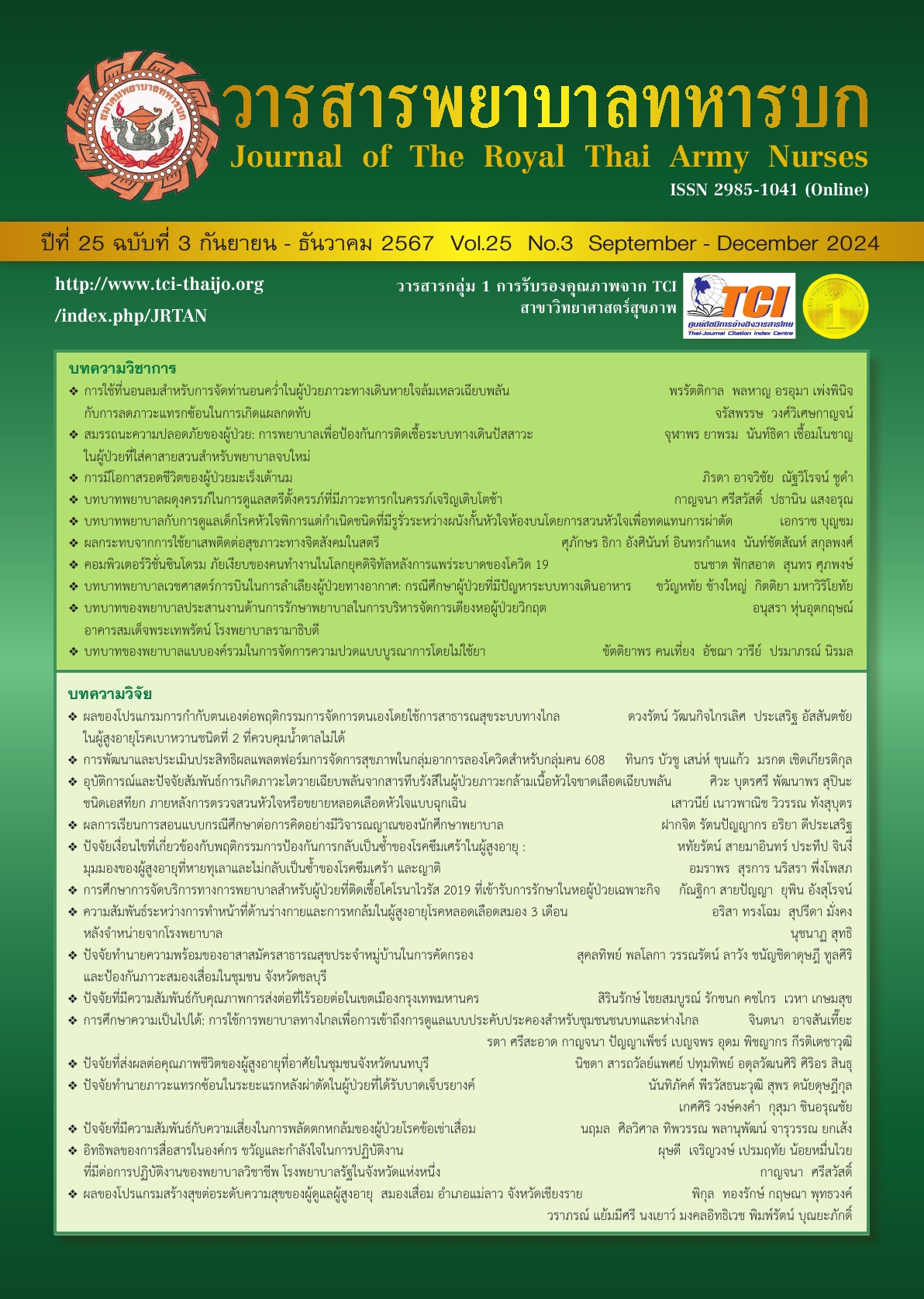Effect of the Job Rotation Program on Task Performance of Nursing Personel in the Out-Patient-Department at a Tertiary Hospital
Keywords:
Job Rotation, Task Performance, Nursing PersonelAbstract
The objectives of this one-group quasi-experimental research were to compare the nursing personnel’s performance before and after the experiment.The sample group consisted of nursing personnel at the outpatient department of Ratchaburi Hospital selected using simple random sampling. The sample group was divided into one group of 20 personnel performance before and after the experiment with rotational assignments. The research instruments used were a questionnaire asking about personal data and the performance of duty of nursing personnel.The content validity index was 0.98, and Cronbach’s alpha coefficient was 0.86 The statistics used were descriptive statistics of frequency, percentage, mean, and standard deviation; and inferential statistics of paired t-test.
The study found that the mean for the performance of duty among the personnel in before the experiment was at a moderate level of 2.92 ( = 2.92, SD = .12) no significant difference but that of after the experiment was at the highest level of 4.62(
= 4.62, SD = .13) The statistical test showed that the mean score for the performance of duty among the personnel in after the experimental with rotational assignments was most level than that of the before with regular assignments at a statistical significance of (p < .05)
This research suggests that Nursing administrators can use the job rotation program to improve their management. To develop all-round work skills through job rotation and it is one of the management tools to develop personnel for the results and success of the nursing organization.
Downloads
References
Koopmans L, Bernaards CM, Hildebrandt VH, de Vet HC, & van der Beek AJ. Measuring individual work performance: identifying and selecting indicators. Work. 2014; 48(2):229-38. doi: 10.3233/WOR-131659. PMID: 23803443.
Ibrahim SAE, Sayed RIE, Attala MM, & Elmezin NK. Relationship between Head Nurses’ Leadership Styles and Staff Nurses’ Job Performance. Journal of Nursing and Science. 2016; 5(1), 66-74. doi:10.9790/1959-05146674
Sonnentag S, & Frese M. Performance concepts and performance theory. Psychological management of individual performance. 2001; 23(1), 3-25.
Armstrong M, & Baron A. Performance management: A strategic and integrated approach to achieve success. Mumbai: Jaico Publishing House; 2007.
Marquis BL, & Huston CJ. Leadership roles and management function in nursing theory and application 3rd. Philadelphia: Lippincott; 2000.
Eriksson T, & Ortega J. The Adoption of Job Rotation: Testing the Theories. Industrial and Labor Relations Review. 2006; 59(4), 653-66.
Arya A, & Mittendorf B. Using Optional Job Rotation Programs to Gauge On-the-Job Learning. Journal of Institutional and Theoretical Economics (JITE). Mohr Siebeck, Tübingen. 2006;162(3), 505-15.
Sriboonwong L, Singchangchai P, & Aree P. The relationship model among transformational leadership of head nurses, innovative work behavior and task performance as perceived by professional nurses in general hospitals. Thai Journal of Cardio-Thoracic Nursing. 2020; 31(2),96-111. (in Thai)
Chaleoykitti S, Kamprow P, & Promdet S. Patient Safety and Quality of Nursing Service. Journal of The Royal Thai Army Nurses. 2014; 15(2), 66-70. (in Thai)
Academy To Innovate HR [Internet]. Bangkok Thailand: Available from: Academy To Innovate HR: AIHR: 2016.
Greenslade JH & Jimmieson NL. Distinguishing between task and contextual performance for nurses: development of a job performance scale. Journal of Advanced Nursing. 2007; 58(6), 602-11.
Borman WC & Motowidlo SJ. Expanding the Criterion Domain to Include Elements of Contextual Performance. Personnel Selection in Organizations San Francisco: Jossey-Bass. 1993.
Coleman VI, & Borman WC. Investigating the underlying structure of the citizenship performance domain. Human Resource Management Review. 2000; 10, 25-44.
Ortega J. Job Rotation as a Learning Mechanism. Management Science. 2001; 47(10), 1361-70.
Campion MA, Cheraskin L, & Stevens MJ. Career-Related Antecedents and Outcomes of Job Rotation. The Academy of Management Journal. 1994; 37(6), 1518-42.
Wongcharoen W, Singchungchai P, Wongkhomthong J & Meehanpong P. The Structural Equation Model of Leadership of In-Patient Unit Head Nurses as Perceived by Professional Nurses, Nurses’ Work Engagement, and Job Performance of Professional Nurses in Community Hospitals. Journal of The Royal Thai Army Nurses. 2018; 19(3), 97-106. (in Thai)
Thailand Nursing and Midwifery Council 2006. Nursing service management standards at the primary, secondary and tertiary levels. Government gazette 2005.
Downloads
Published
How to Cite
Issue
Section
License
Copyright (c) 2024 Journal of The Royal Thai Army Nurses

This work is licensed under a Creative Commons Attribution-NonCommercial-NoDerivatives 4.0 International License.
บทความหรือข้อคิดเห็นใดใดที่ปรากฏในวารสารพยาบาลทหารบกเป็นวรรณกรรมของผู้เขียน ซึ่งบรรณาธิการหรือสมาคมพยาบาลทหารบก ไม่จำเป็นต้องเห็นด้วย
บทความที่ได้รับการตีพิมพ์เป็นลิขสิทธิ์ของวารสารพยาบาลทหารบก
The ideas and opinions expressed in the Journal of The Royal Thai Army Nurses are those of the authors and not necessarily those
of the editor or Royal Thai Army Nurses Association.






